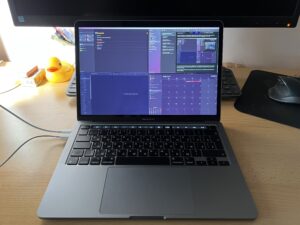So, after reading the previous post regarding Vagrant you are eager to find out what config will enable you to run most PHP-based projects locally, be it written on Laravel, WordPress, Drupal or whatever. Indeed there is already Laravel homestead, but sometimes it takes ages to download, is storage heavy, and does not give you the satisfaction of manually tinkering with the settings. If you want to learn how to make one yourself, then you are in the right spot.
You can find everything neatly in the Vagrant PHP starter repository: https://github.com/dragomirt/vagrant-php-starter
How does it compare to Laravel Homestead?
It’s pretty simple, it provides you find control over things that Laravel Homestead abstracts. For instance:
- Fine tuning of component versions
- Using alternative services
- Using Apache instead of Nginx
- Installing as little or as much as desired
- Spinning the box for each project separately to have better separation of concerns
Ok, so how do I install it?
Below you can find the services and specs that you get by using this setup:
The package includes
- Debian 10
- PHP 7.3
- Composer
- MySQL 5.8
- Redis
- Imagick
- Apache 2
- Configured dpkg
- nfs
- htaccess support
- and much more!
It’s made of 2 components, as usual:
Vagrantfile and provision.sh
Vagrantfile
These are the settings based on which the provider creates the VM. Here you can change the amount of available RAM, CPU cores, network address, storage syncing and much more. These are explained in another article.
Vagrant.configure("2") do |config|
config.vm.provider "virtualbox" do |v|
v.memory = 1536
v.cpus = 2
end
config.vm.box = "debian/buster64"
config.vm.network "private_network", ip: "192.168.33.10"
config.vm.synced_folder ".", "/home/dragomirtcom/dragomirt.com/public", type: "nfs"
config.vm.provision :shell, path: "provision.sh"
endProvision.sh
This is the place where everything gets installed on the first run. When you will deploy your project to the production environment, you can use snippets from this very file to install the required tools and settings for where the application rolls out. It is up to you to decide what to add here, since it’s really just an automated command prompt. Everything you can do in a term, can be replicated here.
#!/usr/bin/env bash
# Use single quotes instead of double quotes to make it work with special-character passwords
DATABASE_NAME='vagrant_boilderplate'
PASSWORD='database_password1'
XDEBUG_INI_PATH='/etc/php/7.3/mods-available/xdebug.ini'
export DEBIAN_FRONTEND=noninteractive
sudo ex +"%s@DPkg@//DPkg" -cwq /etc/apt/apt.conf.d/70debconf
sudo dpkg-reconfigure debconf -f noninteractive -p critical
# update / upgrade
echo "Updating repos..."
sudo apt-get update
#sudo apt-get -y upgrade
# install latest apache and php 7.3
echo "Installing apache2..."
sudo apt-get install -y apache2 1> /dev/null
echo "Installing PHP 7.3..."
sudo apt-get install -y php7.3 1> /dev/null
echo "Installing PHP modules..."
sudo apt-get install -y php-mbstring 1> /dev/null
sudo apt-get install -y php-json 1> /dev/null
sudo apt-get install -y php-soap 1> /dev/null
sudo apt-get install -y php-dom 1> /dev/null
sudo apt-get install -y php-curl 1> /dev/null
sudo apt-get install -y php-zip 1> /dev/null
sudo apt-get -y install php-mysql 1> /dev/null
sudo apt-get -y install php-redis 1> /dev/null
sudo apt-get install -y php-gd 1> /dev/null
sudo apt-get install -y php-imagick 1> /dev/null
echo "Installing Xdebug 2.7..."
sudo apt-get install -y php-xdebug 1> /dev/null
sudo echo "xdebug.remote_enable=true" >> $XDEBUG_INI_PATH
sudo echo "xdebug.remote_connect_back=true" >> $XDEBUG_INI_PATH
sudo echo 'xdebug.remote_host="192.168.33.10"' >> $XDEBUG_INI_PATH
sudo echo "xdebug.idekey=PHPSTORM" >> $XDEBUG_INI_PATH
sudo echo "xdebug.remote_port=9000" >> $XDEBUG_INI_PATH
sudo echo "xdebug.remote_autostart=on" >> $XDEBUG_INI_PATH
sudo echo "xdebug.max_nesting_level=1000" >> $XDEBUG_INI_PATH
sudo service apache2 restart
# install mysql and give password to installer
echo "Installing MySQL Server..."
sudo debconf-set-selections <<< "mysql-server mysql-server/root_password password $PASSWORD" 1> /dev/null
sudo debconf-set-selections <<< "mysql-server mysql-server/root_password_again password $PASSWORD" 1> /dev/null
sudo apt-get -y install default-mysql-server 1> /dev/null
sudo replace "127.0.0.0" "0.0.0.0" -- /etc/mysql/mariadb.conf.d/50-server.cnf
sudo mysql -u root -p${PASSWORD} -e "SET PASSWORD FOR 'root'@'localhost' = PASSWORD('$PASSWORD');"
sudo mysql -u root -p${PASSWORD} -e "UPDATE mysql.user SET Host='%' WHERE Host='localhost' AND User='root';"
sudo mysql -u root -p${PASSWORD} -e "FLUSH PRIVILEGES"
sudo service mysql restart
sudo mysql -u root -p${PASSWORD} -e "create database ${DATABASE_NAME}"
sudo mysql -u root -p${PASSWORD} -e "create database ${DATABASE_NAME}"
echo "Installing Redis Server..."
sudo apt-get -y install redis 1> /dev/null
echo "Installing SQLite"
sudo apt-get -y install sqlite3 1> /dev/null
sudo apt-get -y install php7.3-sqlite 1> /dev/null
sudo service apache2 restart
# install phpmyadmin and give password(s) to installer
# for simplicity I'm using the same password for mysql and phpmyadmin
#sudo debconf-set-selections <<< "phpmyadmin phpmyadmin/dbconfig-install boolean true"
#sudo debconf-set-selections <<< "phpmyadmin phpmyadmin/app-password-confirm password $PASSWORD"
#sudo debconf-set-selections <<< "phpmyadmin phpmyadmin/mysql/admin-pass password $PASSWORD"
#sudo debconf-set-selections <<< "phpmyadmin phpmyadmin/mysql/app-pass password $PASSWORD"
#sudo debconf-set-selections <<< "phpmyadmin phpmyadmin/reconfigure-webserver multiselect apache2"
#sudo apt-get -y install phpmyadmin
echo "Setting up apache..."
# setup hosts file
VHOST=$(cat <<EOF
<VirtualHost *:80>
DocumentRoot "/home/dragomirtcom/dragomirt.com/public/"
<Directory "/home/dragomirtcom/dragomirt.com/public/">
AllowOverride All
Require all granted
</Directory>
</VirtualHost>
EOF
)
echo "${VHOST}" > /etc/apache2/sites-available/000-default.conf
# enable mod_rewrite
sudo a2enmod rewrite 1> /dev/null
# restart apache
service apache2 restart 1> /dev/null
# install git
echo "Installing git..."
sudo apt-get -y install git 1> /dev/null
# install curl
echo "Installing curl..."
sudo apt-get -y install curl 1> /dev/null
# install vim
echo "Installing vim..."
sudo apt-get -y install vim 1> /dev/null
# install Composer
echo "Installing composer..."
curl -s https://getcomposer.org/installer | php 1> /dev/null
mv composer.phar /usr/local/bin/composer
echo "Configuring .bashrc..."
echo 'PROJECT_PATH="/home/dragomirtcom/dragomirt.com/public"' >> ~/.bashrc
echo 'alias l="ls -alt"' >> ~/.bashrc
echo 'alias gtp="cd $PROJECT_PATH"' >> ~/.bashrc
sh ~/.bashrc
echo "Provisioning done!"Conclusion
Even though Laravel Homestead is awesome, sometimes you want some more control and creativity creating your project, and for that you need a mallable environment, which can be easily replicated on the production. As an introduction this boilerplate gives you the minimum for a modern web application, and enables you to add as much as required for application of any level of complexity.
Thanks for reading!
If you have a suggestion, please feel free to let me know below or on any social media!



